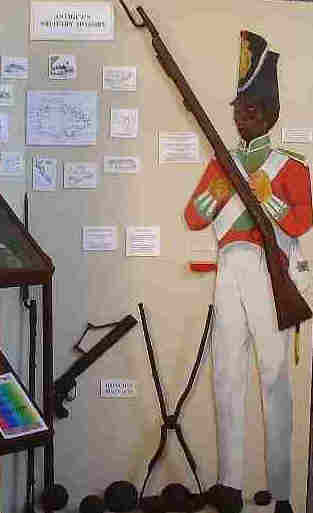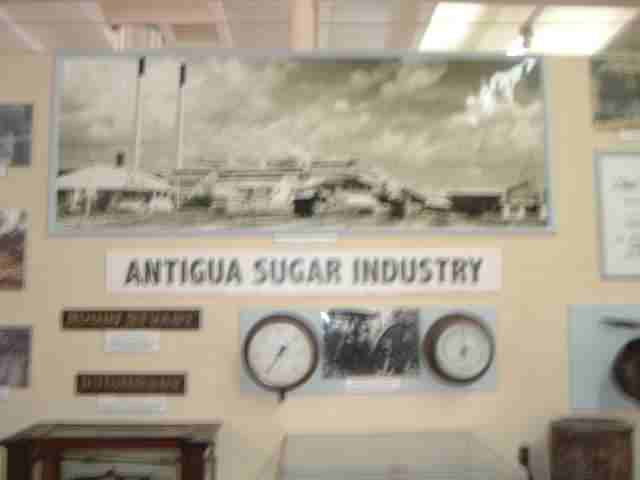Rest cursor on picture for CAPTION
Double-click for larger size - Then BACK!
THE BIRTH OF ANTIGUA
Three diagrams of the island’s formative volcano. “Corals along with many calcareous marine animals provided millions of tons of skeletal debris that built up most of Antigua and Barbuda”. Specimens of the Corals of Antigua and Barbuda are shown.
GEOLOGY OF ANTIGUA
Maps of Antigua and Barbuda showing the geological divisions are shown with rock samples.
ECO-SYSTEM OF ANTIGUA
Here is a chart showing the eco-systems of Antigua mainly using mammals as examples.
FOSSILS
Probably the most interesting of the samples shown are the fossilised fish from the Central Plain. Other examples are sponges, corals and even guano from Redonda.
ROCKS
Here is a fine display of the different types of rock found in our islands.
ANCIENT SHORELINES and FIRST PEOPLE, ARCHAIC AGE
A map presents Antigua & Barbuda's shorelines at 10,000 BC. About 9,600 BC Antigua & Barbuda islands were separated by a rise of sea-level. The west coast configuration at 2,000 BC is also shown with sea levels 10 ft higher than today. A map of Antigua shows the location of the first people's (archaic) sites. Representative artifacts are shown next to the map. There is an axe from Claremont, stone pendants, pestles, shell adzes, flint knives. THEIR FOOD - Crabs, shells, parrotfish jaws.
HOW FLINT & SHELL TOOLS WERE MADE
Method of manufacture of flint tools, flint knives, cores, with hammer stones. Process of manufacture of an adze from a conch shell.
ARAWAKS PRESENCE IN THE CARIBBEAN
“Arawaks" arrived at about the time of Christ. They voyaged by canoe from South America from about 35 A.D.” - A map of the Caribbean with movement arrows shows “Arawak” Indian origins. Styles of pottery from other lands, eg. Montserrat, Virgin Is., Hispaniola. Amerindian names of the islands. Dates of important Amerindian sites.
ARCHAEOLOGY EXCAVATION
This is a reconstruction of Crabb’s peninsular (simplified). Explanation of levels in Antigua’s history, from its birth to present day garbage!
ADORNMENTS
In this case is a display of ear ornaments, earrings. Shell necklaces. Black & white beads, round beads. Worked shell. Body Stamps. Roucou pod and ball, with pictures of painted Amerindians. Necklaces, comb, rattle and bamboo skirt of today’s Amerindians of S. America.
ARAWAKS’ MENU
Part of Food exhibit, cassava plant info. A typical “Menu” of Amerindian fare.
CASSAVA PREPARATION
A Cassava preparation exhibit with cassava paddle, sifter. Model squeezer. Cassava griddles and a whale vertebra disk grater from Indian Creek can be seen.
PLANT INTRODUCTIONS are listed with drawings of plants. Native plants. Uses of plants. Amerindian native dyes.
FISHING & HUNTING METHODS
List of methods are shown with a fish trap model. Fish Hook manufacture. Reproductions of animal and bird traps. Throwing stick. Flint and fire hardened spearheads. Food remains (bones) of birds, shells, turtle, rice rat, iguana, grouper.
CANOE
On the floor is a full sized model hollowed out canoe with fish and fishing equipment inside.
SEASHELLS OF ANTIGUA & BARBUDA
“Shell was a favourite medium for early artists because of its abundance, natural beauty and suggestive shapes”. Display of the common shells of Antigua and Barbuda.
CRAFTWORK
This exhibit shows some woodcraft tools - axes, adzes. Another with cotton on a spindle from South America to compare with spindle whorls from Antigua. Prehistoric weaves are shown imprinted on pottery sherds.
POTTERY
This case shows styles and examples of Amerindian pottery with their periods, and there is a reconstructed firepot with erect handles to keep the hands from burning. Ceramics - How pottery was made, a model of coiling. Pottery shaping and engraving tools from Antiguan sites.
RELIGION
Narcotics were burnt in special ceramic vessels. The basis of Amerindian religion is explained. “Arawak art was a religious art” The Amerindian Gods are named and their places of abode shown (Zemies). Art designs and motifs found in Antigua’s soils are drawn. A ground stone axe from Jolly Beach is displayed.
On the ledge is an image fashioned from a large piece of coral from Barbuda and there is a large “Zemie” from Puerto Rico in which the God “Yocahu” is said to reside.
WEAPONS/ WARFARE
Various implements are shown including a Carib War Club (Boutou), as is a bow and arrow. There are arrowheads and a human vertebrae contains an arrow head and a shell spearhead from Indian Creek.
On the case are some examples of present day Carib basketwork from Dominica where the descendants of the Caribs still reside.
AMERINDIAN NAMES OF THE ISLANDS
The wonderful dictionary of the Carib Language published by Father Breton in 1660 is shown. The origin of Amerindian names of the islands including “Waladli” has been found in this book. There are engravings of Caribs, a Carib carving and model canoe from Dominica in this exhibit.
THE COLONIAL PAST
A 6 ft. long map of Antigua (1748) shows the estates and owner's names. Below are weights and measures of unusual units from colonial times ,once used as a standard for weighing and measuring sugar exports.
THE ARRIVAL OF THE EUROPEANS
Columbus is the central figure here. A map shows his voyages. Buccaneers are mentioned.
COLONISATION
There is a map showing the earliest colonial settlements and there are artifacts of the period.
TRIANGLE TRADE
A map of the North Atlantic shows the infamous triangular trade from Great Britain to Africa and on over the Atlantic with human cargoes.
SLAVERY
Posters advertising slaves are shown and there is a picture showing the branding of slaves.
SUGAR PRODUCTION
A fine diagram shows the various stages of sugar production and there are artifacts appertaining to the sugar process.
PLANTATION BALANCE SHEET
An enlarged copy of a sugar plantation ledger page is displayed and there are more sugar artifacts.
SHIPWRECKS
A large wall map of the islands of Antigua and Barbuda names the many ship wrecks around their shores. There also a number of artifacts recovered from various wrecks.
ANTIGUA’S MILITARY HISTORY

This display shows a map of the location of Antigua's many ancient fortifications. Also shown are army insignia, weapons and other paraphernalia.
Some information is given about the West India Regiments that served in Antigua and Barbuda in the early 19th century,
Information on the Antigua Barbuda Defence Force is pending ...
SLAVE RESISTANCE
This is retold by labels under the headings of Protest, Maroons and the 1736 conspiracy.
A MODEL SUGAR PLANTATION 1900
Model Sugar Estate made by William Thibou about 1900. A real antique!
EMANCIPATION
UPSTAIRS - Post emancipation history is shown in a separate room.
VIVI RICHARDS BAT/ BALL/ SHIELD
The Museum is proud to possess and display the cricket bat of our national cricket hero and a ball used by another, Andy Roberts.
STATE OF ANTIGUA
Explains the symbolism of our national flag
ANTIGUA/ BARBUDA/ REDONDA



There is a fine display of artifacts that refer to Antigua's Sugar Industry and artifacts relating the Antigua way of living in the early 20th century.